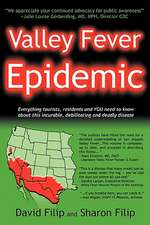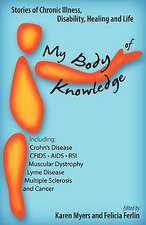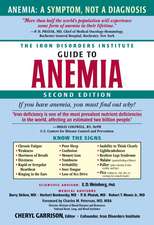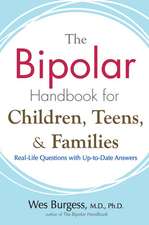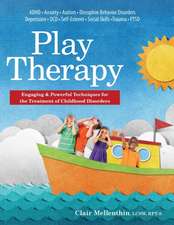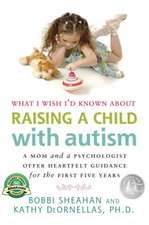The Autism Revolution: Whole-Body Strategies for Making Life All It Can Be
Autor Martha Herbert, Karen Weintrauben Limba Engleză Paperback – 11 mar 2013
After years of treating patients and analyzing scientific data, Harvard Medical School researcher and clinician Dr. Martha Herbert offers a revolutionary new view of autism and a transformative strategy for dealing with it. Autism, she concludes, is not a hardwired impairment programmed into a child’s genes and destined to remain fixed forever. Instead, it is the result of a cascade of events, many seemingly minor. And while other doctors may dismiss your child’s physical symptoms—the anxiety, sensory overload, sleeplessness, frequent illnesses or seizures—as coincidental or irrelevant, Dr. Herbert sees them as vital clues to what the underlying problems are, and how to help. Drawing from the newest research, technologies, and insights, as well as inspiring case studies of both children and adults, Dr. Herbert guides you toward restoring health and resiliency in your loved one with autism. Her specific recommendations aim to provide optimal nutrition, reduce toxic exposures, limit stress, and open the door to learning and creativity. As thousands of families who have cobbled together these solutions themselves already know, this program can have dramatic benefits—for your child with autism, and for you, your whole family, and perhaps your next baby as well.
“Invaluable . . . a must-read . . . Dr. Martha Herbert gets it. She not only gets it, but she puts it out there in an awesome book so the rest of us can get it, too.”—Autism Watch
“[Herbert] goes further than most autism specialists. Her impressive science background merges with common sense and even intuitive sense [making] complex scientific and medical materials seamlessly blend with a holistic viewpoint.”—Relieve Autism
“Hope and practical guidance . . . With this easy-to-read book, parents can gain wisdom on how to guide your child to achieve a healthy and thriving life.”—Mom Central
Preț: 106.45 lei
Nou
Puncte Express: 160
Preț estimativ în valută:
20.38€ • 22.14$ • 17.13£
20.38€ • 22.14$ • 17.13£
Carte disponibilă
Livrare economică 31 martie-14 aprilie
Preluare comenzi: 021 569.72.76
Specificații
ISBN-13: 9780345527202
ISBN-10: 0345527208
Pagini: 320
Dimensiuni: 134 x 209 x 17 mm
Greutate: 0.23 kg
Editura: BALLANTINE BOOKS
ISBN-10: 0345527208
Pagini: 320
Dimensiuni: 134 x 209 x 17 mm
Greutate: 0.23 kg
Editura: BALLANTINE BOOKS
Notă biografică
Martha Herbert, MD, PhD, is an assistant professor of neurology at Harvard Medical School and a pediatric neurologist at Massachusetts General Hospital, where she is the director of the TRANSCEND Research Program. She sits on the Scientific Advisory Committee for Autism Speaks.
Karen Weintraub, MA, is an award-winning journalist and freelance health writer for outlets like The Boston Globe, USA Today, and the BBC. A past recipient of a prestigious Knight Center for Science Journalism fellowship, she also teaches journalism at the Harvard Extension School and Boston University.
Karen Weintraub, MA, is an award-winning journalist and freelance health writer for outlets like The Boston Globe, USA Today, and the BBC. A past recipient of a prestigious Knight Center for Science Journalism fellowship, she also teaches journalism at the Harvard Extension School and Boston University.
Extras
CHAPTER 1
Go for the Extraordinary
Caleb tore himself away from a game with his sisters, bounced into the kitchen, and asked his mom what she was making for dinner. It was one of his favorites: gluten-free pasta and ground beef.
He started to turn back to the girls, but paused. “Mom,” he said, as casually as if he were commenting on the weather, “my autism is gone.”
“How do you know?” his astonished mother managed to ask.
“It’s easy to be with people now,” the ten-year-old said matter-of-factly, and then headed back to his younger sisters.
Joy Petersen stared, dumbfounded for a few seconds in the middle of the kitchen. It wasn’t until two months later that she realized he was right.
Caleb has his father’s bright blue eyes, his mother’s dark hair, and a complexion that reflects his mixed Dominican American heritage. He is still looking up at five feet, and his voice remains a little boy’s for now. He wants to be a zoologist when he grows up, and is already talking about going away to college, although he understands that his parents will be sad to see him go.
Joy recently took him to a new doctor, a specialist in treating children with autism and other special needs. Caleb noticed the photographs covering the doctor’s wall and asked why the doctor was holding a gun in one of them. After talking to Caleb and his parents for a while, the doctor announced that Caleb didn’t fit the criteria for autism anymore. “Yeah!” Caleb said, jumping up and pumping his arms. His mother began to sob uncontrollably.
Joy used to dream of the day someone would say her son was no longer autistic. Of the day he’d come up to her, say he loved her, and really mean it.
That day was unimaginable when Caleb was four, still had no language, and was so afraid that he would wail and cry when anyone other than his parents came within five feet. Joy said she would put her fingertips on his body and he would scream as if somebody had hit him. Taking care of Caleb was so overwhelming that she would often find herself in tears. There were times when she was so afraid of hurting him in her anger and stress, that she’d put him down, walk into her bedroom, shut herself in her closet, and collapse on the floor, crying.
The doctors and therapists told her she had to be realistic. Your son will probably be like this forever, they said. You can try lots of different things, but none has been proven to work.
Joy decided to start trying them anyway. And to her surprise, everything seemed to work, at least a little. No one thing took the autism away, she said, but all of it put together helped a lot.
By the time Caleb was in first grade, everyone thought she’d succeeded. He was able to follow simple instructions. His repetitive behaviors—the spinning, stick tapping, and high-pitched noises—had mostly stopped. He was able to sit in a mainstream classroom with an aide. This is as good as he’s going to get, they told Joy. You’ve done the best you can.
But she wasn’t satisfied. Her heart told her that there was more to do.
“I still had a disconnected boy,” she said.
“People would tell me he’s high functioning, he follows directions—and I’m like that’s not what I want . . . I want a boy I can look in the eye and tell him I love him, and he knows what I’m saying . . . I want a boy who can look me in the eye and tell me he loves me . . . I want a boy who can take in the world and absorb it, not run away from it . . . Absorb it, not run away from it,” she repeats for emphasis.
She has that boy now.
See What We Believe or Believe What We See
For decades, most doctors told parents that autism was a genetic problem in their child’s brain, and that it wasn’t going anywhere—that they should expect their toddler’s troubles would be with him/her forever. Autism had long been defined by its deficits, by what the child is believed unable to do: communicate, control himself, function like everyone else. Parents might make improvements around the edges—reduce the tantrums, limit the crazy behaviors, get the child to follow directions—but the essential deficits would remain.
After years of researching autism and treating patients at Massachusetts General Hospital, after years of meeting children like Caleb, I have come to the conclusion that the views I had been taught simply couldn’t be right.
I have met many, many people like Caleb who are doing remarkably well, often after making improvements more dramatic than anyone ever dreamed possible. Some showed amazing bursts of improvement, transforming from nonverbal and withdrawn to A-student with lots of friends. Some reached adulthood with a stable job and just a few quirks. Some still can’t talk but communicate through painting, music, eloquent words typed on a keyboard, or glassblowing. Some, now adults, are professionals, parents, artists, friends, or all of the above.
It may be difficult to imagine now, as you are struggling to help a four-year-old who screams more than he speaks, but many people with autism have grown up to lead fulfilling, productive lives.
The more I worked with my patients, the more I realized I had a choice: to “see what I believed” or to “believe what I see.” If I believed that autism was a genetically determined, lifelong brain impairment, then I would have to deny to myself the extraordinary capabilities and changes I saw in my patients. If I believed what I saw, then I would have to rethink everything I knew about autism.
That’s what I proceeded to do, and you are reading the result of that exploration.
For going on a decade and a half, I have thrown myself into taking a fresh look at autism. I have probed into generations of science and compared the research with the theories built around this evidence. I have been inspired by a growing body of exciting new findings and new areas of research, which point to new ways of helping people with autism. And I have allowed myself to be touched by people with autism who offered me fresh perspectives and ideas and expanded my world.
More than Genes and Brain: Also Whole Body and Environment
In all my research and reading, I have never found proof of the genes-hopelessly-mess-up-the-brain-for-life model of autism. Genes absolutely affect the brain, but there’s no solid proof that they’re the only players.
Geneticists have been searching for autism’s “smoking gun” for more than a decade. But though more discoveries are on the way, so far they have only identified genetic “defects” in a small minority of people with autism—leaving the vast majority of cases of autism genetically unexplained.
Meanwhile, babies who seem normal for the first year or two regress into autism. Scientists used to believe that all autism was caused by brain damage before birth. Some children with autism do seem different from the start. But a lot of children appear perfectly fine before slipping away over weeks or months. Studies of home videos and direct observations have confirmed that this occurs. Regression into autism makes it hard to just blame genes that kick in late, and makes you wonder about whether environmental stressors play a role, too.
And many children do get better. There is no proof behind the common assumption that if the diagnosis involves a genetic mutation—such as fragile X or idic(15), or others presumed present but not found yet—the person is totally frozen with “impairment” and “deficits” for life. In 2008 I was among a group of researchers who published an article called “Can children with autism recover? If so, how?” Some of these researchers had shown that between 3 and 25 percent of children once diagnosed with autism are eventually told they do not have the condition. How could this happen? Their genes certainly don’t change in a few years, so they were either misdiagnosed or, as in the case of Caleb—who was rigorously diagnosed—after lots of treatment, their symptoms faded so much that they no longer belong on the autism spectrum. Many others who don’t “recover” still greatly improve.
Autism can even change over minutes, hours, or days—and then change back. Children with fever or on steroids for a medical problem like asthma can show improvements in communication and social interaction, which fade after the fever goes away or the steroids are stopped. If autism were totally genetically hardwired this couldn’t happen.
Moreover, genetics cannot explain the rising frequency of the condition. When I first got involved in autism research in 1995, people thought that 1 out of every 3,300 children had autism. As I write, the figure is approaching 1 in 100. Genes take generations to evolve, so either we have been oblivious to autism, or something other than genetics is causing autism more often. There is still some debate about whether autism is truly rising or whether factors like greater awareness and diagnosing people we would have missed in the past are causing at least part of the increase.
By now, most researchers agree that genes usually don’t act on their own to cause autism. Genes may lead to vulnerability—they may “load the gun”—but so much of the time, it’s environment that “pulls the trigger.”
Finally, although I’m a Harvard neurologist—an expert in the brain and nervous system—I have come to believe that just as autism is not simply a genetics problem, it is not simply a brain problem, either. Autism involves the whole body. As a physician, I’ve seen so many autistic children with similar medical problems that I can’t believe it’s just a coincidence. And we know through thousands of scientific papers and an ocean of clinical experience that the health of the body can affect the function of the brain.
At this point, I think there is enough evidence to say that while autism certainly involves the brain, it is really a problem of the whole body, including the brain, from molecules to cells, from organs to metabolism, from immune to digestive systems. Even for those with autism who show no obvious medical problems, take a careful look for hidden issues.
An Autism Revolution
If you add environment to genes, add body to brain, take seriously the powerful brilliance of many people with autism and the profound transformations and loss of diagnoses we are seeing more and more, you get a very different story than the “hopeless-genetic-lifelong-brain-damage” tale that most of us thought was the truth.
The story you get is of problems that can be solved, illness that can be healed, and extraordinary capabilities that can come out of hiding and make powerful impacts on the world.
Caleb got better, in part, because his mother was persistent and she believed in his full potential even when everyone told her he had improved enough. If he could really get better, how many other kids can get better, too? How many others have hidden brilliance that the world needs to see? How many more can feel happier and more comfortable? My commitment is to transform autism so everyone gets their best shot at becoming all they can be. I know so many children like Caleb and so many brilliant and fulfilled people with autism that I feel ethically obliged to tell these stories so we can figure out what makes them possible. Armed with this knowledge, we can go forward and make this great opportunity accessible to as many people as we can. Your child may not be able to make the transformation that Caleb has—their kind of autism may work differently, or need another kind of approach. But right now we can’t tell who can broaden their options and who can’t, so we should hold out the possibility of real, meaningful quality-of-life improvements for everyone.
Journey to the Revolution
How did I get from the genes-broke-the-brain approach to the whole-body, transformative approach that I am giving you now? Through my patients, and through my science.
My Patients
When I finished my neurology training in the mid-1990s, I started doing research, and I began seeing lots of children with learning and behavioral problems. In my clinic, I thought my job as a pediatric neurologist was to see if I could find underlying medical reasons for the difficulties the children were having. I was taught to run genetic tests, to look for seizures and “inborn errors of metabolism”—serious, known diseases of the body’s electrical and chemical systems. I dutifully ran all the required tests, and 9 times out of 10, I didn’t find anything diagnosable. But that didn’t mean that everyone who tested normally on these tests was fine—far from it. Instead I kept noticing that many of my patients weren’t feeling well. Some of them experienced frequent infections, some had diarrhea, some couldn’t sleep, some had rashes, and lots had allergies. Many had all of the above. A lot had all kinds of additional problems that didn’t necessarily fit their diagnosis and a troublingly large number came in with whole strings of diagnoses, as well as a long list of specialists they were seeing and boatloads of medications.
I began asking my patients more medical questions—not just about the brain but about everything I could think of. I also started realizing that these patients needed help with their whole-body problems, not just with their behavior and learning problems. It dawned on me that while I had been trained to look for rare genetic and metabolic conditions, most of my patients were suffering from much more common problems that were being overlooked by pediatricians and other specialists.
What kept frustrating me with my patients was that their problems often didn’t meet the criteria for any diagnosable disease. They seemed to be in a “gray zone”—in a no-man’s-land between solidly healthy and clearly diseased. The EEG test I used to examine their brain waves would have unusual electrical spikes and rhythms that seemed to indicate a problem, but since there was no evidence of seizures their test results usually read “probably normal.” Their metabolic studies would show abnormal levels of chemicals and nutrients, but the official report would read “abnormalities do not fit any known pattern. Normal study.” A colonoscopy might show signs of inflammation, but not enough to meet criteria for ulcerative colitis or Crohn’s disease. And without a clear diagnosis, there was no standard treatment to prescribe. Some parents told me that as toddlers their children were unable to sleep more than two hours at a time, bounced off the walls all day long, and had frequent diarrhea so acidic that it would blister their skin and burn through the couch cushions. But so often they were told “this is a stage; your child will grow out of it.”
As this played out over and over again, I kept thinking of the story about the doctor who tells the patient, “There is nothing wrong with you. But on the other hand, there is nothing right with you, either.”
Go for the Extraordinary
Caleb tore himself away from a game with his sisters, bounced into the kitchen, and asked his mom what she was making for dinner. It was one of his favorites: gluten-free pasta and ground beef.
He started to turn back to the girls, but paused. “Mom,” he said, as casually as if he were commenting on the weather, “my autism is gone.”
“How do you know?” his astonished mother managed to ask.
“It’s easy to be with people now,” the ten-year-old said matter-of-factly, and then headed back to his younger sisters.
Joy Petersen stared, dumbfounded for a few seconds in the middle of the kitchen. It wasn’t until two months later that she realized he was right.
Caleb has his father’s bright blue eyes, his mother’s dark hair, and a complexion that reflects his mixed Dominican American heritage. He is still looking up at five feet, and his voice remains a little boy’s for now. He wants to be a zoologist when he grows up, and is already talking about going away to college, although he understands that his parents will be sad to see him go.
Joy recently took him to a new doctor, a specialist in treating children with autism and other special needs. Caleb noticed the photographs covering the doctor’s wall and asked why the doctor was holding a gun in one of them. After talking to Caleb and his parents for a while, the doctor announced that Caleb didn’t fit the criteria for autism anymore. “Yeah!” Caleb said, jumping up and pumping his arms. His mother began to sob uncontrollably.
Joy used to dream of the day someone would say her son was no longer autistic. Of the day he’d come up to her, say he loved her, and really mean it.
That day was unimaginable when Caleb was four, still had no language, and was so afraid that he would wail and cry when anyone other than his parents came within five feet. Joy said she would put her fingertips on his body and he would scream as if somebody had hit him. Taking care of Caleb was so overwhelming that she would often find herself in tears. There were times when she was so afraid of hurting him in her anger and stress, that she’d put him down, walk into her bedroom, shut herself in her closet, and collapse on the floor, crying.
The doctors and therapists told her she had to be realistic. Your son will probably be like this forever, they said. You can try lots of different things, but none has been proven to work.
Joy decided to start trying them anyway. And to her surprise, everything seemed to work, at least a little. No one thing took the autism away, she said, but all of it put together helped a lot.
By the time Caleb was in first grade, everyone thought she’d succeeded. He was able to follow simple instructions. His repetitive behaviors—the spinning, stick tapping, and high-pitched noises—had mostly stopped. He was able to sit in a mainstream classroom with an aide. This is as good as he’s going to get, they told Joy. You’ve done the best you can.
But she wasn’t satisfied. Her heart told her that there was more to do.
“I still had a disconnected boy,” she said.
“People would tell me he’s high functioning, he follows directions—and I’m like that’s not what I want . . . I want a boy I can look in the eye and tell him I love him, and he knows what I’m saying . . . I want a boy who can look me in the eye and tell me he loves me . . . I want a boy who can take in the world and absorb it, not run away from it . . . Absorb it, not run away from it,” she repeats for emphasis.
She has that boy now.
See What We Believe or Believe What We See
For decades, most doctors told parents that autism was a genetic problem in their child’s brain, and that it wasn’t going anywhere—that they should expect their toddler’s troubles would be with him/her forever. Autism had long been defined by its deficits, by what the child is believed unable to do: communicate, control himself, function like everyone else. Parents might make improvements around the edges—reduce the tantrums, limit the crazy behaviors, get the child to follow directions—but the essential deficits would remain.
After years of researching autism and treating patients at Massachusetts General Hospital, after years of meeting children like Caleb, I have come to the conclusion that the views I had been taught simply couldn’t be right.
I have met many, many people like Caleb who are doing remarkably well, often after making improvements more dramatic than anyone ever dreamed possible. Some showed amazing bursts of improvement, transforming from nonverbal and withdrawn to A-student with lots of friends. Some reached adulthood with a stable job and just a few quirks. Some still can’t talk but communicate through painting, music, eloquent words typed on a keyboard, or glassblowing. Some, now adults, are professionals, parents, artists, friends, or all of the above.
It may be difficult to imagine now, as you are struggling to help a four-year-old who screams more than he speaks, but many people with autism have grown up to lead fulfilling, productive lives.
The more I worked with my patients, the more I realized I had a choice: to “see what I believed” or to “believe what I see.” If I believed that autism was a genetically determined, lifelong brain impairment, then I would have to deny to myself the extraordinary capabilities and changes I saw in my patients. If I believed what I saw, then I would have to rethink everything I knew about autism.
That’s what I proceeded to do, and you are reading the result of that exploration.
For going on a decade and a half, I have thrown myself into taking a fresh look at autism. I have probed into generations of science and compared the research with the theories built around this evidence. I have been inspired by a growing body of exciting new findings and new areas of research, which point to new ways of helping people with autism. And I have allowed myself to be touched by people with autism who offered me fresh perspectives and ideas and expanded my world.
More than Genes and Brain: Also Whole Body and Environment
In all my research and reading, I have never found proof of the genes-hopelessly-mess-up-the-brain-for-life model of autism. Genes absolutely affect the brain, but there’s no solid proof that they’re the only players.
Geneticists have been searching for autism’s “smoking gun” for more than a decade. But though more discoveries are on the way, so far they have only identified genetic “defects” in a small minority of people with autism—leaving the vast majority of cases of autism genetically unexplained.
Meanwhile, babies who seem normal for the first year or two regress into autism. Scientists used to believe that all autism was caused by brain damage before birth. Some children with autism do seem different from the start. But a lot of children appear perfectly fine before slipping away over weeks or months. Studies of home videos and direct observations have confirmed that this occurs. Regression into autism makes it hard to just blame genes that kick in late, and makes you wonder about whether environmental stressors play a role, too.
And many children do get better. There is no proof behind the common assumption that if the diagnosis involves a genetic mutation—such as fragile X or idic(15), or others presumed present but not found yet—the person is totally frozen with “impairment” and “deficits” for life. In 2008 I was among a group of researchers who published an article called “Can children with autism recover? If so, how?” Some of these researchers had shown that between 3 and 25 percent of children once diagnosed with autism are eventually told they do not have the condition. How could this happen? Their genes certainly don’t change in a few years, so they were either misdiagnosed or, as in the case of Caleb—who was rigorously diagnosed—after lots of treatment, their symptoms faded so much that they no longer belong on the autism spectrum. Many others who don’t “recover” still greatly improve.
Autism can even change over minutes, hours, or days—and then change back. Children with fever or on steroids for a medical problem like asthma can show improvements in communication and social interaction, which fade after the fever goes away or the steroids are stopped. If autism were totally genetically hardwired this couldn’t happen.
Moreover, genetics cannot explain the rising frequency of the condition. When I first got involved in autism research in 1995, people thought that 1 out of every 3,300 children had autism. As I write, the figure is approaching 1 in 100. Genes take generations to evolve, so either we have been oblivious to autism, or something other than genetics is causing autism more often. There is still some debate about whether autism is truly rising or whether factors like greater awareness and diagnosing people we would have missed in the past are causing at least part of the increase.
By now, most researchers agree that genes usually don’t act on their own to cause autism. Genes may lead to vulnerability—they may “load the gun”—but so much of the time, it’s environment that “pulls the trigger.”
Finally, although I’m a Harvard neurologist—an expert in the brain and nervous system—I have come to believe that just as autism is not simply a genetics problem, it is not simply a brain problem, either. Autism involves the whole body. As a physician, I’ve seen so many autistic children with similar medical problems that I can’t believe it’s just a coincidence. And we know through thousands of scientific papers and an ocean of clinical experience that the health of the body can affect the function of the brain.
At this point, I think there is enough evidence to say that while autism certainly involves the brain, it is really a problem of the whole body, including the brain, from molecules to cells, from organs to metabolism, from immune to digestive systems. Even for those with autism who show no obvious medical problems, take a careful look for hidden issues.
An Autism Revolution
If you add environment to genes, add body to brain, take seriously the powerful brilliance of many people with autism and the profound transformations and loss of diagnoses we are seeing more and more, you get a very different story than the “hopeless-genetic-lifelong-brain-damage” tale that most of us thought was the truth.
The story you get is of problems that can be solved, illness that can be healed, and extraordinary capabilities that can come out of hiding and make powerful impacts on the world.
Caleb got better, in part, because his mother was persistent and she believed in his full potential even when everyone told her he had improved enough. If he could really get better, how many other kids can get better, too? How many others have hidden brilliance that the world needs to see? How many more can feel happier and more comfortable? My commitment is to transform autism so everyone gets their best shot at becoming all they can be. I know so many children like Caleb and so many brilliant and fulfilled people with autism that I feel ethically obliged to tell these stories so we can figure out what makes them possible. Armed with this knowledge, we can go forward and make this great opportunity accessible to as many people as we can. Your child may not be able to make the transformation that Caleb has—their kind of autism may work differently, or need another kind of approach. But right now we can’t tell who can broaden their options and who can’t, so we should hold out the possibility of real, meaningful quality-of-life improvements for everyone.
Journey to the Revolution
How did I get from the genes-broke-the-brain approach to the whole-body, transformative approach that I am giving you now? Through my patients, and through my science.
My Patients
When I finished my neurology training in the mid-1990s, I started doing research, and I began seeing lots of children with learning and behavioral problems. In my clinic, I thought my job as a pediatric neurologist was to see if I could find underlying medical reasons for the difficulties the children were having. I was taught to run genetic tests, to look for seizures and “inborn errors of metabolism”—serious, known diseases of the body’s electrical and chemical systems. I dutifully ran all the required tests, and 9 times out of 10, I didn’t find anything diagnosable. But that didn’t mean that everyone who tested normally on these tests was fine—far from it. Instead I kept noticing that many of my patients weren’t feeling well. Some of them experienced frequent infections, some had diarrhea, some couldn’t sleep, some had rashes, and lots had allergies. Many had all of the above. A lot had all kinds of additional problems that didn’t necessarily fit their diagnosis and a troublingly large number came in with whole strings of diagnoses, as well as a long list of specialists they were seeing and boatloads of medications.
I began asking my patients more medical questions—not just about the brain but about everything I could think of. I also started realizing that these patients needed help with their whole-body problems, not just with their behavior and learning problems. It dawned on me that while I had been trained to look for rare genetic and metabolic conditions, most of my patients were suffering from much more common problems that were being overlooked by pediatricians and other specialists.
What kept frustrating me with my patients was that their problems often didn’t meet the criteria for any diagnosable disease. They seemed to be in a “gray zone”—in a no-man’s-land between solidly healthy and clearly diseased. The EEG test I used to examine their brain waves would have unusual electrical spikes and rhythms that seemed to indicate a problem, but since there was no evidence of seizures their test results usually read “probably normal.” Their metabolic studies would show abnormal levels of chemicals and nutrients, but the official report would read “abnormalities do not fit any known pattern. Normal study.” A colonoscopy might show signs of inflammation, but not enough to meet criteria for ulcerative colitis or Crohn’s disease. And without a clear diagnosis, there was no standard treatment to prescribe. Some parents told me that as toddlers their children were unable to sleep more than two hours at a time, bounced off the walls all day long, and had frequent diarrhea so acidic that it would blister their skin and burn through the couch cushions. But so often they were told “this is a stage; your child will grow out of it.”
As this played out over and over again, I kept thinking of the story about the doctor who tells the patient, “There is nothing wrong with you. But on the other hand, there is nothing right with you, either.”
Recenzii
Advance praise for The Autism Revolution
“Martha Herbert’s book gives us a new approach to understanding how autism affects many different body systems. It is essential reading for learning more about sensible biomedical treatments.”—Temple Grandin, author of Thinking in Pictures and The Way I See It
“This book offers hope and practical guidance to heal your child’s whole body system. It will be an important reference for everyone who knows someone with autism or has an interest in the field to read, study, and use.”—Robert L. Hendren, DO, professor and vice chair, Department of Psychiatry, and director, Child and Adolescent Psychiatry, University of California, San Francisco
“Combining meticulous, world-class research on autism’s biomedical causes and treatment with an artful presentation of the condition as a whole-body phenomenon, Martha Herbert elevates to a new level the thinking about, understanding of, and developing of interventions for supporting individuals on the autism spectrum. The Autism Revolution is a unique and valuable resource.”—Stephen M. Shore, EdD, assistant professor of special education at Adelphi University
“Written by a brilliant scientist in easy-to-understand language, The Autism Revolution gives parents two life-changing gifts. First is the gift of realistic hope; the second is the gift of knowledge. Drawing upon her vast knowledge of research and an eclectic array of approaches, Dr. Herbert helps parents understand their child in a new, holistic way, sending them on a journey of exploration and opportunity.”—John L. Martin, director, Ohio Department of Developmental Disabilities
“The Autism Revolution is a remarkable book. Complex evidence is summarized in easy-to-read prose, and practical advice is sprinkled throughout the book. A convincing case is made that autism is a disorder of both the brain and the body, and that there are many features of the environment—from the foods we eat to the pollutants that we breathe—that may play a role. This book will provide a blueprint for the future research agenda on this fascinating condition.”—Richard J. Davidson, William James and Vilas Professor of Psychology and Psychiatry, and founder and chair, Center for Investigating Healthy Minds, University of Wisconsin-Madison
“It is clear that Dr. Herbert cares deeply about the subject of autism and the people affected by it. Covering the topic as a physician, a scientist, an anthropologist, and a philosopher, she uses her exploration of autism to guide people to possible factors they may not have considered.”—Timothy Buie, MD, assistant professor of pediatrics, Harvard Medical School
“Martha Herbert’s book gives us a new approach to understanding how autism affects many different body systems. It is essential reading for learning more about sensible biomedical treatments.”—Temple Grandin, author of Thinking in Pictures and The Way I See It
“This book offers hope and practical guidance to heal your child’s whole body system. It will be an important reference for everyone who knows someone with autism or has an interest in the field to read, study, and use.”—Robert L. Hendren, DO, professor and vice chair, Department of Psychiatry, and director, Child and Adolescent Psychiatry, University of California, San Francisco
“Combining meticulous, world-class research on autism’s biomedical causes and treatment with an artful presentation of the condition as a whole-body phenomenon, Martha Herbert elevates to a new level the thinking about, understanding of, and developing of interventions for supporting individuals on the autism spectrum. The Autism Revolution is a unique and valuable resource.”—Stephen M. Shore, EdD, assistant professor of special education at Adelphi University
“Written by a brilliant scientist in easy-to-understand language, The Autism Revolution gives parents two life-changing gifts. First is the gift of realistic hope; the second is the gift of knowledge. Drawing upon her vast knowledge of research and an eclectic array of approaches, Dr. Herbert helps parents understand their child in a new, holistic way, sending them on a journey of exploration and opportunity.”—John L. Martin, director, Ohio Department of Developmental Disabilities
“The Autism Revolution is a remarkable book. Complex evidence is summarized in easy-to-read prose, and practical advice is sprinkled throughout the book. A convincing case is made that autism is a disorder of both the brain and the body, and that there are many features of the environment—from the foods we eat to the pollutants that we breathe—that may play a role. This book will provide a blueprint for the future research agenda on this fascinating condition.”—Richard J. Davidson, William James and Vilas Professor of Psychology and Psychiatry, and founder and chair, Center for Investigating Healthy Minds, University of Wisconsin-Madison
“It is clear that Dr. Herbert cares deeply about the subject of autism and the people affected by it. Covering the topic as a physician, a scientist, an anthropologist, and a philosopher, she uses her exploration of autism to guide people to possible factors they may not have considered.”—Timothy Buie, MD, assistant professor of pediatrics, Harvard Medical School





